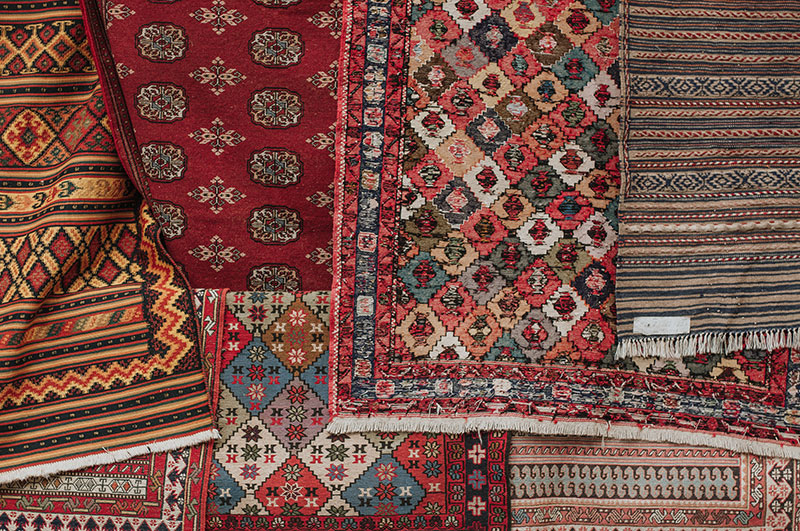Advertisement
There are countless rug options on the market right now, with many catering to modern, bold designs. But there’s something so timeless about ornate, vintage rugs with history. Turkish rugs are more than just a piece of decor—they are an art cultivated by centuries of artists in Turkey. The most high-quality Turkish rugs are handwoven and feature intricate patterns and tight weaves.
A Nomadic Art
According to Serhat Engul of Istanbul Clues, an Istanbul tour guide, the history of Turkish rugs dates back to 400 BCE. Carpets were originally created to benefit nomadic tribes in Turkey and parts of Central Asia. Nomads who traveled in tents used carpets, making it easier to stand on uneven ground. Sometimes, these carpets were even woven while nomads were traveling. Non-travelers might have used a vertical loom to make their carpets while travelers would have used a horizontal loom that would be fixed into the ground. Turkish carpets were considered particularly beautiful and durable by visiting Europeans. They became popular in paintings from the Renaissance era with painters such as Hans Holbein and Lorenzo Lotto depicting the ornate rugs.
Functional, Natural Materials
Wool is valued in Turkish rugs for its durability and luster while cotton can be used to highlight certain aspects of a wool design because of its natural whiteness (Kilim Studio). Finally, camel, horse, and goat hair is used to add durability to a Turkish rug and was especially common in Turkish carpets that were used as tent or floor covers. Wool strands are often dyed with natural materials like vegetables and indigo to give them their vibrant color. Red, orange, yellow, green, blue, brown, and white are some of the most common colors that you might see in Turkish rugs. Vibrant, primary, and secondary colors are favored more than neutral tones.
Patterns and Motifs
The Turks used a special weaving technique called the Ghiordes knot, now called the Turkish or symmetrical knot, which brings both ends between the warp (vertical) yarns (Britannica). Turkish carpets are typically made of a mixture of wool, cotton, and silk and feature geometric shapes and flowers. Interestingly enough, many of the symbols and geometric patterns depicted on Turkish rugs are symbols of femininity and fertility. Motifs of hair bands and earrings in a rug may indicate the weaver’s desire to get married. A pentagonal shape with a curved, upside-down triangular top may be a stylized depiction of a woman while a shape that resembles a ram’s horns likely symbolizes masculinity. Yinyang-like symbols stand for love, stars for happiness, and eye-like or cross-like shapes as protections against evil (Kilim Studio). Some Turkish families even have specific family signs that they incorporate into their designs, making certain vintage rugs a lasting legacy of a Turkish family.
Kilims
One particular type of Turkish rug, known as a kilim, features bold designs and a unique weaving style (Kilim Studio). The flatweave, which is performed by weaving the weft (horizontal) yarns with the warp (vertical) yarns, gives the kilim rug its unique pattern and texture. Kilim rugs have been traditionally associated with geometric patterns because of yet another technique known as the slitweave. This allows slits of space to be left between a change in fabric color, making the kilim more durable overall.
If you’re looking for a truly unique kilim, you might just be able to find one with gold and silver threads or beads woven throughout it. These indicate an artistic choice on the part of the weaver, making these rugs one-of-a-kind. If you’re in love with a kilim or Turkish rug design but are afraid to put it on the floor, you can always hang it or drape it over a chair or couch. There are even kilim bags and pillows.
The Making of a Kilim
Like most handwoven rugs, kilims are made on looms. The loom holds the warp (vertical) strands while the weaver weaves the weft (horizontal) strands into them. Looms were traditionally made of wood, although today, many loom machines are adjustable or even automatic. Traditionally, a tool known as a “beating comb” made of wood or bone was used to comb down the horizontal strands of yarn, weaving them tightly together (Kilim Studio). Rather than weaving the Turkish rug by hand, some weavers prefer to use a tool called a “shuttle” which allows the horizontal strands to weave between the vertical strands with more ease.
Because the weaving of Turkish rugs is such an intricate art, it’s difficult to find authentic Turkish rugs outside of Turkey. The Sultanahmet area of Istanbul has some of the most beautiful Turkish carpets, but luckily, certain retailers specialize in outsourcing vintage Turkish rugs and restoring them. This means you won’t have to book a flight to Turkey to find the perfect Turkish rug—just look online to find authentic Turkish masterpieces that have already been restored.

